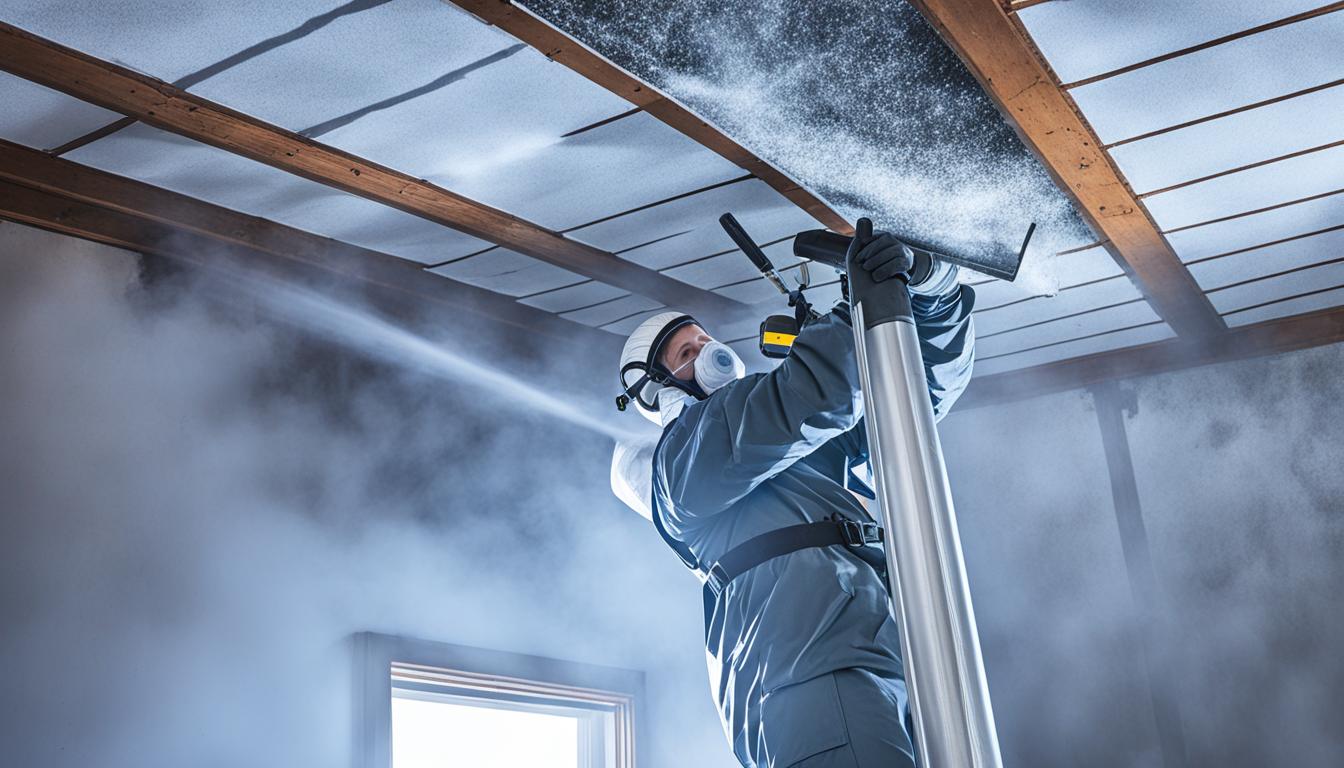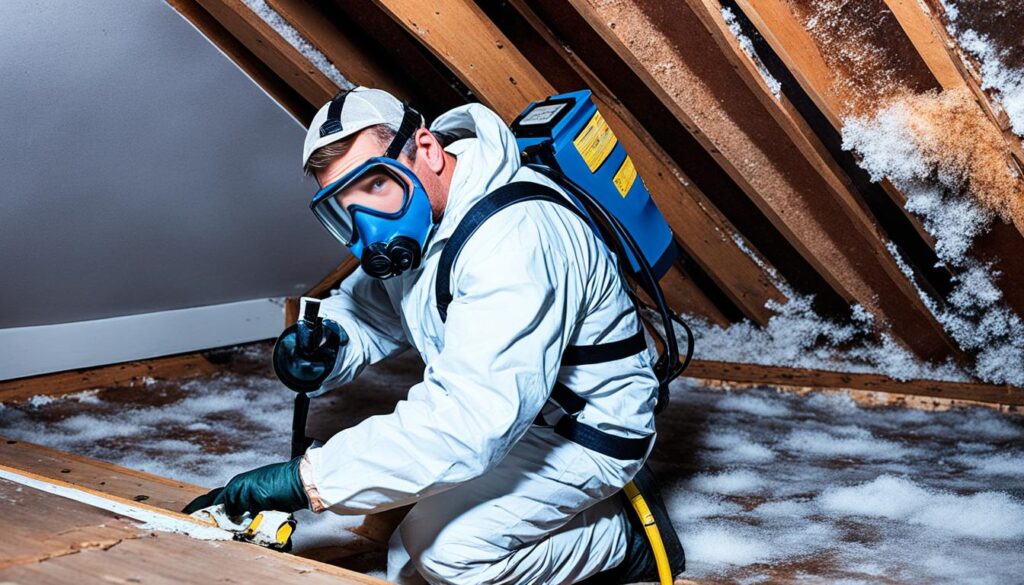
Attic Mold Remediation: How to Fix Mold in Attic
Welcome to our comprehensive guide on attic mold remediation. If you’ve discovered mold in your attic, it’s crucial to address the issue promptly to avoid potential health risks and structural damage to your home. In this article, we will provide you with effective methods to fix mold in the attic, ensuring a safe and mold-free environment for you and your family.
Attic mold remediation involves the removal, treatment, and cleanup of mold growth in the attic space. Mold can thrive in attics due to various factors such as poor ventilation, high humidity levels, and water leaks. If left unattended, mold can spread rapidly and compromise the air quality in your home.
Before we dive into the step-by-step process of mold removal, let’s explore the causes of attic mold and the importance of regular mold inspections. Understanding these factors will help you prevent future mold problems and maintain a healthy living environment.
Key Takeaways:
- Attic mold remediation is essential to ensure a safe and mold-free environment in your home.
- Mold can thrive in attics due to poor ventilation, high humidity levels, and water leaks.
- Regular mold inspections are crucial to identify mold growth early and prevent further damage.
- Fixing mold in the attic involves a step-by-step process of removal, treatment, and cleanup.
- Professional assistance from companies like Fix Mold Miami can provide expert mold assessments and remediation services.
Understanding Attic Mold and Its Causes
When it comes to maintaining a healthy home environment, addressing mold issues is crucial. Mold growth in the attic is a common problem that many homeowners face. Not only can it result in structural damage and compromise indoor air quality, but it can also pose potential health risks.
Attic mold inspection plays a vital role in early detection and prevention of mold growth. By understanding the causes of attic mold, homeowners can take proactive measures to mitigate its development. Let’s explore the common factors that contribute to mold growth in attics and discuss preventive strategies to keep your home mold-free.
Common Causes of Attic Mold
Attics have specific conditions that make them susceptible to mold growth. These factors include:
- Poor ventilation: Inadequate airflow in the attic can create a moist and stagnant environment, promoting mold growth.
- Humidity: Excessive moisture in the attic, whether from leaks or high humidity levels, can lead to mold formation.
- Inadequate insulation: Insufficient or damaged insulation can cause condensation to form in the attic, creating a favorable environment for mold.
- Roof leaks: Any gaps or leaks in the roof can allow water to seep into the attic, providing the necessary conditions for mold growth.
By addressing these underlying causes, homeowners can significantly reduce the risk of attic mold development.
The Importance of Attic Mold Inspections
Regular attic mold inspections are essential for early detection and prevention of mold growth. Inspections help identify existing mold problems and potential moisture issues that may lead to mold growth in the future. It’s recommended to seek professional assistance for a thorough inspection and assessment of your attic.
“Attic mold inspection is a proactive approach to ensure a healthy living environment. By identifying and addressing mold growth early on, homeowners can save themselves from costly remediation processes and potential health hazards.”
During an attic mold inspection, professionals will assess the condition of the attic, identify any existing mold growth, and determine the underlying causes. They will also provide recommendations for effective mold prevention in the attic.
Preventive Measures for Mold Prevention in Attic
Taking preventive measures is the key to combating attic mold. Here are some effective strategies to prevent mold growth in the attic:
- Ensure proper attic ventilation: Adequate airflow is crucial for maintaining optimal attic conditions. Install vents and fans to promote air circulation and prevent moisture buildup.
- Maintain proper insulation: Well-insulated attics help regulate temperature and prevent condensation. Ensure insulation is properly installed and free from damage.
- Address roof leaks promptly: Regularly inspect the roof for any signs of leakage and promptly address any issues to prevent water from entering the attic.
- Control humidity levels: Use dehumidifiers or moisture-absorbing materials to control humidity in the attic. Keep an eye on indoor humidity levels and maintain them within the recommended range.
- Maintain a clean and clutter-free attic: Regularly clean the attic and remove any unnecessary items that may trap moisture.
Implementing these preventive measures can greatly reduce the chances of mold growth in your attic and contribute to a healthier living environment.
By understanding the causes of attic mold and the importance of attic mold inspections, homeowners can take proactive measures and prevent mold problems in their homes. In the next section, we will discuss in detail the step-by-step process of fixing mold in the attic.

Steps to Fix Mold in Attic
If you’ve discovered mold in your attic, it’s crucial to address the issue promptly to prevent further damage and ensure a healthy living environment. Here, we provide a step-by-step guide on how to fix mold in the attic, along with essential precautions and equipment needed for attic mold removal.
Step 1: Protective Gear
Before starting the mold removal process, it is important to prioritize your safety. Put on protective gear, including gloves, goggles, and a respirator, to shield yourself from mold spores and potential health risks during the cleaning process.
Step 2: Identify the Source
Identify the source of moisture that caused the mold infestation in your attic. Common sources include roof leaks, improper ventilation, or plumbing issues. Addressing the underlying cause is essential to prevent future mold growth.
Step 3: Contain the Area
Isolate the affected area to prevent the spread of mold spores throughout your home. Close off the attic and cover any openings, such as vents and ducts, with plastic sheets and tape.
Step 4: Remove Contaminated Materials
Remove any mold-infested materials from the attic, such as insulation, drywall, or carpeting. Place the contaminated materials in large, sealed bags to prevent further contamination during disposal.
Step 5: Clean and Disinfect
Thoroughly clean the attic using a HEPA vacuum cleaner to remove any loose mold spores. Next, use a mixture of water and detergent or a specialized mold cleaner to clean all surfaces. Once clean, apply a disinfectant to kill any remaining mold spores.
Step 6: Dry the Area
Avoid further mold growth by ensuring the attic is completely dry. Use fans, dehumidifiers, or open windows to increase airflow and facilitate the drying process. It is essential to maintain a dry environment to prevent future mold problems.
Step 7: Proper Ventilation
Install proper ventilation systems, such as roof vents or attic fans, to improve air circulation in the attic. Adequate ventilation helps prevent the buildup of moisture, reducing the risk of mold growth in the future.
| Precautions | Equipment |
|---|---|
|
|
By following these steps and taking the necessary precautions, you can effectively fix mold in your attic and create a mold-free environment in your home.

Professional Assistance for Attic Mold Remediation
When it comes to fixing mold issues in your attic, seeking professional assistance is crucial for effective remediation. Mold problems can be complex and require specialized knowledge and equipment to address. That’s where Fix Mold Miami comes in.
Fix Mold Miami is Florida’s Highest Rated In Mold Assessments, Prevention, and Remediation company. With their years of experience and expertise, they offer comprehensive solutions to tackle attic mold problems head-on.
Services Offered by Fix Mold Miami:
- Mold assessment and inspection: Fix Mold Miami conducts thorough assessments to identify the extent of mold growth in your attic. Their experts use advanced techniques and tools to accurately assess the situation.
- Mold removal and remediation: Once the problem has been assessed, Fix Mold Miami employs proven techniques for safe and efficient mold removal. Their team follows industry-standard protocols to ensure complete mold remediation.
- Preventive measures: Fix Mold Miami doesn’t just fix the mold problem; they also help prevent future mold growth in your attic. Their experts will provide guidance on measures that can be taken to minimize the risk of mold recurrence.
If you’re facing mold issues in your attic, don’t hesitate to contact Fix Mold Miami for a professional mold assessment. Their team can be reached at 305-465-6653. Take the necessary steps to restore a mold-free and healthy environment in your home.
Conclusion
In conclusion, addressing mold issues in the attic is crucial for maintaining a healthy and safe home environment. The presence of attic mold can lead to various health issues and structural damages, making it essential to take prompt action.
Throughout this article, we discussed effective methods of attic mold remediation, including the importance of attic mold inspections, steps for fixing mold in the attic, and the benefits of seeking professional assistance.
By following the recommended steps and preventive measures, homeowners can ensure a mold-free attic and reduce the risk of mold-related problems. However, it is important to remember that attic mold remediation can be complex and potentially hazardous. Therefore, if you are unsure or faced with extensive mold growth, it is recommended to seek professional help from experts like Fix Mold Miami.
Don’t compromise on your family’s health and the integrity of your home. Take action today to address mold issues in your attic and create a clean and safe living environment for you and your loved ones.




